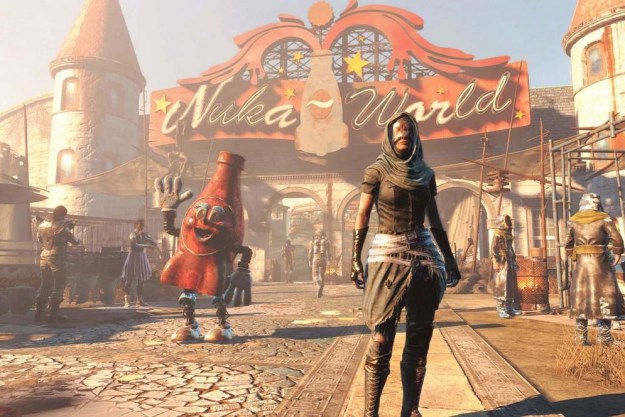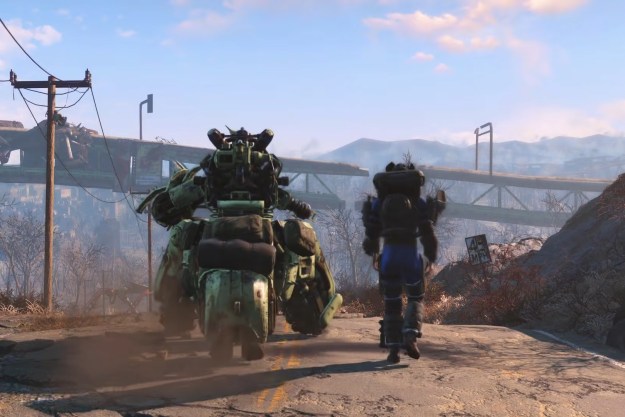Dark Souls developer FromSoftware is diving back into the mind-shattering challenge driven formula it’s cultivated in games like Bloodborne and the Souls franchise. Now partnering with Call of Duty and Destiny publisher Activision, its newest creation, Sekiro: Shadows Die Twice, takes its Soulslike formula in a faster, more mobile direction.
In a hands-off demo at E3 2018, FromSoftware showed us a game that seems, at its very simplest, like a cross between the combat ideas of Dark Souls or Bloodborne and quicker, slightly stealthier action in games like Assassin’s Creed. It’s not about slowly whittling down opponents or overpowering them — it’s about seeing an opening and using it to stab them through the heart. After Bloodborne sped up the slower gameplay of the Dark Souls formula, Sekiro feels like a natural next step.
Becoming the “One-Armed Wolf”
Sekiro takes place in the late 16th century in Japan, but FromSoftware made it clear that this is not a historically accurate game. Instead, it’s a dark, original take on the world, with a setting meant to invoke the nation’s natural beauty. Players take on the role of the ninja Sekiro, whose master, “the Young Lord,” is kidnapped by an evil character described only as “The Rival.” When that happens, you’re defeated (and maybe even killed) by the Rival, losing an arm in the fight. Once you recover, you become “the one-armed wolf” and take on a new mission: Save the Young Lord, and take revenge on the one who took your limb.
The upshot of being a ninja with a severed arm you get to replace it with something much more useful — “The Shinobi prosthetic.” Your replacement arm is a ninja multi-tool that gives you a number of useful skills, including a built-in grappling hook to scale buildings and the ability to wield heavy weapons.
Moving up in the world
The grappling hook changes the way players approach Sekiro, especially fans of FromSoftware’s past games. It allows for much more verticality than Dark Souls, allowing you to jump up onto rooftops and catch enemies unawares, find alternate paths through areas, and slingshot yourself at bosses to land different attacks.
Moving strategically will be an important way to scope out enemies and thin out their numbers.
Jumping is actually a key part of the game, as FromSoftware explained during the demo. Moving strategically will be an important way to scope out enemies and thin out their numbers ahead of direct combat, giving you a better chance at victory. It’s also a combat mechanic, though. You’ll leap over powerful attacks or use your aerial advantage to land hits on bad guys. It’s not all jumping, all the time, but players will need to think vertically most of the time.
The best offense is a good defense
When you do face opponents head-on, the primary combat of Sekiro takes on a clashing-of-swords dueling mentality. You’re always carrying a katana in your right hand, and when you go up against enemies, you’re constantly trying to defend and parry against their attacks.
This dueling style revolves around a mechanic similar to the Stamina meter seen in Dark Souls games and Bloodborne called “posture.” In a fight, you’re always trying to wear down each enemy’s posture meter so that you can execute an extremely powerful “Shinobi deathblow” to take them down.

In practice, it means that instead of just standing there, holding the block button to avoid taking damage, you’re trying to time your blocks to your enemies’ strikes to parry their attacks. Not every attack can be blocked or parried, requiring you to keep on your toes, but generally the idea is to break your enemy’s guard so you can find an opening.
Parrying an attack lowers your enemy’s posture, and when they run out, they’re momentarily dazed or staggered, leaving them open to a deathblow. On regular foes, your deathblow is effectively an execution. On larger enemies and bosses, it will trigger a powerful attack that does immense damage.
This dueling style revolves around a mechanic similar to the Stamina meter seen in Dark Souls games and Bloodborne called “posture.”
Since Sekiro is a FromSoftware game, there will be plenty of strange and straight up horrific bosses who force you to alter your strategy. The demo led up to a battle against a huge guy in a set of stocks, flanked by a few samurai. Dodging and parrying attacks was still essential — in any given fight, you’ll spend a lot of time and focus simply staying alive while trying to lower the enemy’s posture — but FromSoftware also showed off other abilities Sekiro can use, including setting his sword on fire and firing a cloud of blood that stuns anyone who walks through it. While FromSoftware is still figuring out the ins and outs of these Shinobi Prosthetic-enabled skills, in the current version of the game you have to kill enemies to charge them up, and they’re costly to execute.
What’s a ninja game without some stealth?
FromSoftware made it clear that Sekiro is an action game with role-playing elements, (though didn’t specify what those were), but there are also some “light stealth mechanics” in the game as well. What exactly is “light stealth?” As a ninja, you can hide up on rooftops or in low bushes, Assassin’s Creed-style, to get close to enemies and take them out without a fight. Sneaking around lets you choose your approach to the battlefield or thin out enemy numbers before you engage the enemies whom you can’t dispose of quietly. With the grappling hook and more traversal capabilities, FromSoftware wants to give you multiple options for approaching battlefields and engaging enemies. Stealth is one of the options you can choose when figuring out how you handle a given situation.
In the demo, we saw how players can slip past enemies, getting the drop on them from the rooftops and executing them, causing gouts of blood spray out of their perforated arteries. With one or two guys executed, the next target was a towering brute in full samurai armor. After blocking, parrying his sword, and wearing him down, the boss’s posture was broken. Sekiro executed him with a vicious stab to the neck.
In another especially interesting portion of the demo found the player finding a way around a broken bridge between two cliffs. Some grappling hook moves took the player down to a mountain path below to find a way past the bridge, but that was quickly blocked — by a giant snake. In a quick stealth portion, the player had to avoid getting spotted by the snake using stealth mechanics, only to nearly get eaten just before slipping into a cave and finding a secret way forward.
These interactions with giant enemies that you can’t just kill will also be a big part of what Sekiro has to offer, and get at the heart of how Sekiro expands on the ideas in FromSoftware’s other titles. Moments like those, and the ubiquitous use of the grappling hook, suggest getting around in Sekiro will be just as important as fighting — and will require players to expand their skills beyond the developer’s approach to tough combat.
Death is a tool. Use it.
It was during the fight with that boss that we got a taste of Sekiro‘s death mechanics. Unlike in Souls games and Bloodborne, death is not quite so devastating in Sekiro. You can resurrect yourself mid-battle after you die. In the demo, Sekiro used his own death as an opportunity to get the drop on a group of enemies who killed him. After reviving himself, he waited until his murderers wandered off, thinking the threat had passed. That made it possible to sneak up and kill one enemy, and stab the boss in the jugular.
Death is not quite so devastating in Sekiro.
FromSoftware wasn’t very detailed about how death will factor into all aspects of Sekiro, but the studio is known for using its death mechanics in interesting and often challenging ways. In the Souls games, dying causes you to drop all the valuable souls you gather from enemies you defeat, which are used to increase your own power (and Bloodborne has a similar mechanic). While that’s obviously not what’s going on in Sekiro, FromSoftware said players should expect a level of tension in the gameplay similar to its other games. You won’t be able revive yourself infinitely, and it sounds like death will still have some major consequences in Sekiro — but it will also be a tool in the player’s arsenal.
Look for Sekiro: Shadows Die Twice in early 2019, on Xbox One, PlayStation 4 and Steam.
Editors' Recommendations
- These Activision Blizzard games need to come to Xbox Game Pass this year
- Player-made mod brings an Easy Mode to Sekiro: Shadows Die Twice








